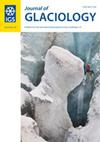基于海拔反演法重建冰下湖泊活动
IF 2.6
3区 地球科学
Q2 GEOGRAPHY, PHYSICAL
引用次数: 0
摘要
冰下湖泊水量变化产生的冰高程异常为冰川和冰盖下的水流提供了线索。这些海拔变化异常的定量解释仍然面临重大挑战,因为冰下湖泊活动的地表表达取决于基础条件、水量变化速率和冰流变学。为了解决这些挑战,我们引入了一种逆方法,该方法在考虑粘性冰流影响的同时,从海拔数据重建冰下湖泊活动。我们使用Stokes冰流模型的线性化近似,假设冰下湖泊活动只引起相对于参考冰流状态的小扰动。我们通过用完全非线性模型生成的合成数据精确地重建湖泊活动来验证这一假设。然后,我们通过反演美国宇航局冰、云和陆地高程卫星2号(ICESat-2)激光测高任务的数据,将该方法应用于估算南极洲几个活跃的冰下湖泊的水量变化。结果表明,由于粘性冰流的影响,反演结果与传统估算方法存在较大差异(20%以上)。逆方法将有助于改进冰下水输送的估计,并进一步限制冰下水文在冰盖演变中的作用。本文章由计算机程序翻译,如有差异,请以英文原文为准。
Reconstructing subglacial lake activity with an altimetry-based inverse method
Abstract Subglacial lake water-volume changes produce ice-elevation anomalies that provide clues about water flow beneath glaciers and ice sheets. Significant challenges remain in the quantitative interpretation of these elevation-change anomalies because the surface expression of subglacial lake activity depends on basal conditions, rate of water-volume change, and ice rheology. To address these challenges, we introduce an inverse method that reconstructs subglacial lake activity from altimetry data while accounting for the effects of viscous ice flow. We use a linearized approximation of a Stokes ice-flow model under the assumption that subglacial lake activity only induces small perturbations relative to a reference ice-flow state. We validate this assumption by accurately reconstructing lake activity from synthetic data that are produced with a fully nonlinear model. We then apply the method to estimate the water-volume changes of several active subglacial lakes in Antarctica by inverting data from NASA's Ice, Cloud, and land Elevation Satellite 2 (ICESat-2) laser altimetry mission. The results show that there can be substantial discrepancies (20% or more) between the inversion and traditional estimation methods due to the effects of viscous ice flow. The inverse method will help refine estimates of subglacial water transport and further constrain the role of subglacial hydrology in ice-sheet evolution.
求助全文
通过发布文献求助,成功后即可免费获取论文全文。
去求助
来源期刊

Journal of Glaciology
地学-地球科学综合
CiteScore
5.80
自引率
14.70%
发文量
101
审稿时长
6 months
期刊介绍:
Journal of Glaciology publishes original scientific articles and letters in any aspect of glaciology- the study of ice. Studies of natural, artificial, and extraterrestrial ice and snow, as well as interactions between ice, snow and the atmospheric, oceanic and subglacial environment are all eligible. They may be based on field work, remote sensing, laboratory investigations, theoretical analysis or numerical modelling, or may report on newly developed glaciological instruments. Subjects covered recently in the Journal have included palaeoclimatology and the chemistry of the atmosphere as revealed in ice cores; theoretical and applied physics and chemistry of ice; the dynamics of glaciers and ice sheets, and changes in their extent and mass under climatic forcing; glacier energy balances at all scales; glacial landforms, and glaciers as geomorphic agents; snow science in all its aspects; ice as a host for surface and subglacial ecosystems; sea ice, icebergs and lake ice; and avalanche dynamics and other glacial hazards to human activity. Studies of permafrost and of ice in the Earth’s atmosphere are also within the domain of the Journal, as are interdisciplinary applications to engineering, biological, and social sciences, and studies in the history of glaciology.
 求助内容:
求助内容: 应助结果提醒方式:
应助结果提醒方式:


